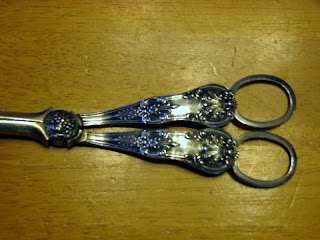Just a brief note to share with you today. I was working on cleaning and sorting through the contents of the sideboard in the dining room today, when I got distracted.
You see, there were some odd bits of silverware in the drawers, and I thought I really should do a little research to find out more about them. Then I could write that information down as well as where those bits came from, and then put both information and bits tidily away. You can imagine how far I got with that job extension!
Anyway, as I was happily puttering my way through my self-appointed task, I was also thinking about tomorrow afternoon's meeting of the Crazy Quilt class. I had already decided what I would work on and even had drawn part of the pattern on my fabric. As I was focusing my camera (and not very well as you will see) on a piece of silverware, those two activities combined in my head - silverware and crazy quilts, that is. Or more clearly put, patterns (where to find them) and embroidery (what to embroider).
Here is very simple, quite elegant pattern, but look at it closely. It consists of a double line. So? Look what that line does! First of all it is a double line whose interior space (width of the handle) changes. At the end of the stem, that line breaks up into angles yet they are gentle angles with hints of curve. Now follow that line down into the bowl of the ladle. Double line meets double line. Instead of an abrupt ending to that sinuous curve of line where the handle ends, it folds back into itself in almost a heart shape (mimicking the angled end). Then the double line motif is picked up again in curve that clearly binds the flowering of the bowl with the stem of the handle. Line is a very useful element in embroidery, this is such a good example of ways to use it!
Here is a pair of fruit scissors/snips - used especially to remove a small cluster of grapes from the larger bunch. Here there are elements galore! While you might not be able to see them clearly, there are three distinct patterns. The very end of the scissors near the finger loops, the middle of the handles, and the roundel where the blades meet. Each pattern is unique but works together to form a whole, and that's what I hope you can see. Look at how the line around the handles creates a border for the design space, but the individual designs are allowed to lap over the borders (middle of the handle). That flower design reaches up into the negative space between it and the end of the handles. Then at the end, the border is a part of the shell-like motif. In this example the flow of the line/border is allowed to be interrupted with curlicues. Finally, the designer has cleverly shaped the pivot point of handles and blades to form the broken borders of the last design element which just happens to be a bunch of grapes with a leaf. Here, you can see how breaking a line works wonders.
Wow! One could use the design ideas or the designs themselves just about anywhere in embroidery. On top of that, these designs are 3-D. Texture is some times overlooked when planning creative stitchery. I'm going to be taking a closer look at the odds and ends in my silverware drawer!


You certainly do have a lot of treasures in your home - and as an artist you see things that others miss! (like me)
ReplyDelete